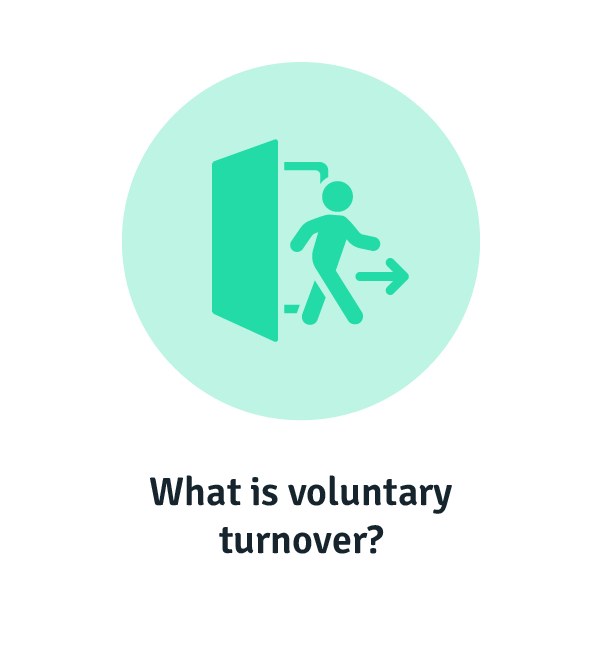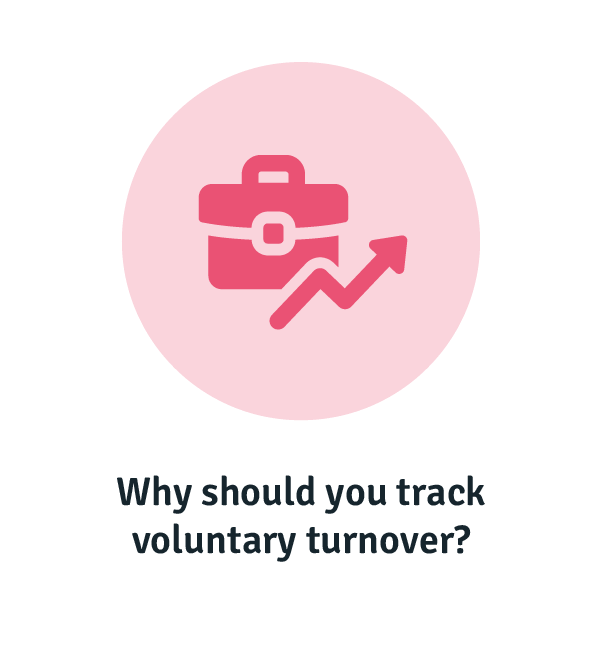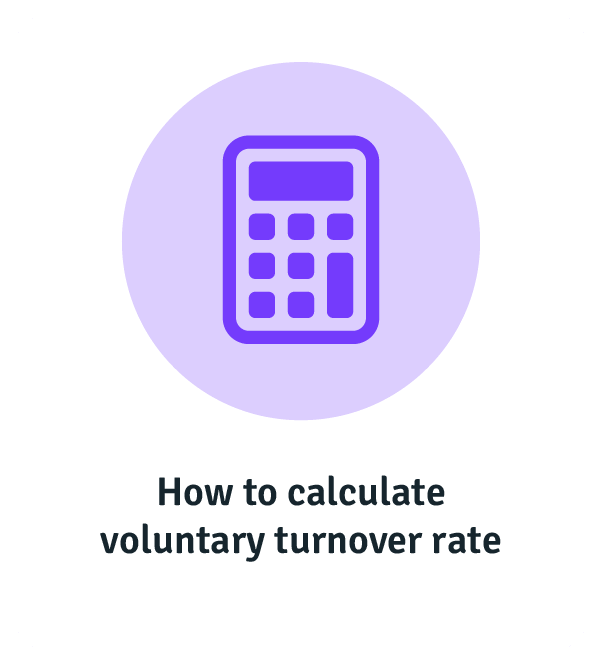Many employers are worried about The Great Attrition—where skilled employees quit at unexpected rates, switch jobs and industries, and move into non-traditional, flexible roles over the traditional 9-5. As a result, the potential for turnover is high—but the root cause may often lie within your organisation rather than outgoing employees.
Losing employees is a natural part of running a business, when you have a healthy turnover rate. It’s when employees willingly decide to depart your organisation that trends can emerge in your business and work environment.
In this article we’ll get into how you can calculate voluntary employee turnover and what that means for your organisation and its future.
What is voluntary turnover?
Voluntary employee turnover refers to the occurrence of employees leaving an organisation over a certain time period based on their own choice rather than that of the business. It occurs naturally as employees willingly leave to seek out new opportunities, making way for new talent and organisational change.
In this way, turnover is not the same as attrition, which encompasses all long-term vacancies and position removals.
The voluntary vs involuntary turnover rate
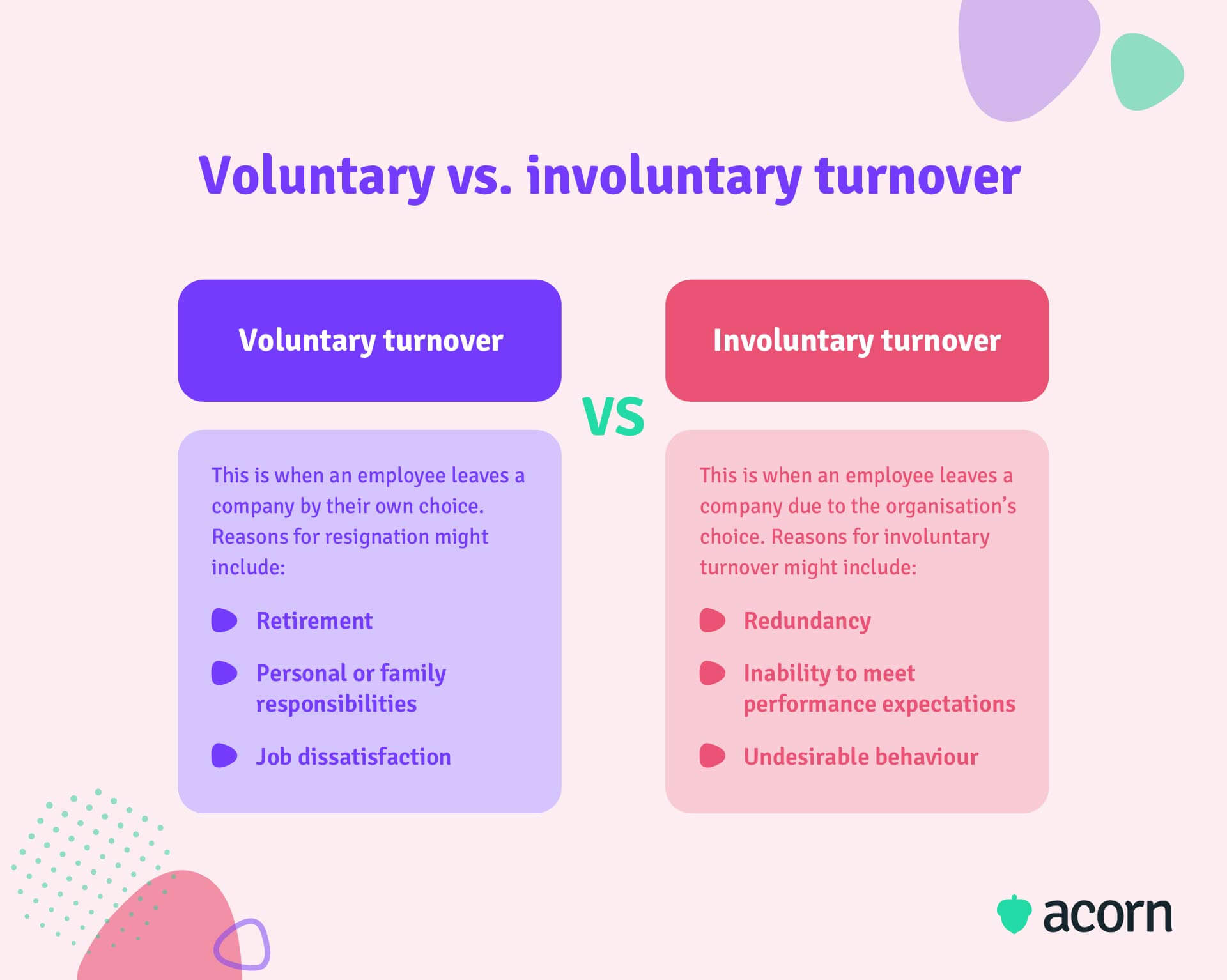
Put simply, voluntary turnover occurs as a result of an employee’s own individual choice. Voluntary turnover might be swayed by external reasons outside of one’s job, or internal factors like the role, team, or organisation itself.
That includes reasons like:
- Family responsibilities
- Relocation
- Health issues
- Lack of flexible working hours
- Poor work-life balance
- Job dissatisfaction
- Company culture
- Retirement.
Involuntary turnover is the opposite. It refers to when organisation’s terminate employee contracts. This could be because of poor performance, undesirable behaviour, or redundancy, making their continued employment with the organisation untenable.
Function vs dysfunction in turnover
Functional turnover is when poor performers leave your organisation, whether voluntarily or involuntarily.
- Functional voluntary turnover occurs when employees identify themselves as unable to meet the standards and expectations of the company, and thus, choose to leave.
- Functional involuntary turnover is when a company identifies and terminates or reassigns employees who aren’t performing as well as they should be.
Dysfunctional turnover occurs when your top performers leave your business at a higher rate than poor performers. This kind of turnover is considered dysfunctional because of the impact it has on your capital due to a loss of productivity and capability and talent shortages.
Why should you track voluntary turnover?
Tracking your overall turnover rate (that is, both your voluntary and involuntary turnover) can be a significant HR metric for businesses, particularly in the case of your voluntary employee turnover. For example, the voluntary turnover rate in 2022 was 25% higher than it was pre-pandemic. So, what does this mean?
When employees leave, you’ll often find out the determining factors behind why employees quit during exit interviews. This can reveal the causes and potential consequences of employee departures, which you can take into consideration for the future of your business.
Identify areas for improvement
A healthy turnover rate reflects a healthy workplace and employee satisfaction, but if your employee turnover rate is unexpectedly high in certain teams, departments, or under certain managers, that could indicate underlying issues. Think poor management, lack of employee engagement, or a toxic workplace culture.
Organisations can use this information to investigate the factors that might be contributing to turnover and take action to address them. That could mean providing more learning opportunities (94% of employees would stay in a job longer if provided with training opportunities), better compensation, or improving workplace conditions to promote a more positive, productive work environment. Remember that many of these initiatives offer greater stability in organisational capability over time, which in turn means a stronger engine from which to drive competitive advantage.
Understanding the effectiveness of L&D on your business performance is essential for recognising the correlation to turnover. That’s why we’ve created the first ever performance learning management system (PLMS) at Acorn. A PLMS guides learners step-by-step to master the specific capabilities of their roles that will accelerate organisational performance and employee engagement. It’s a powerful tool you can use to draw connective lines between performance, training, and voluntary turnover.
Identify the costs of turnover
Turnover, voluntary or not, can be costly for organisations due to lost productivity during the hiring process on top of recruitment and training costs. Tracking voluntary turnover rates allows organisations to estimate turnover costs, meaning they can better understand the financial impact of employee departures and make informed decisions about recruitment, onboarding and retention strategies.
Evaluate the effectiveness of retention strategies
Tracking voluntary turnover reveals trends in staff turnover that you can use to determine the effectiveness of your retention strategies (think training and development programs or flexible work arrangements). For example, when Kathmandu improved their onboarding and training programs in response to high turnover, they noticed a decline in new employees leaving.
How to calculate voluntary turnover rate
Calculating employee turnover rate is a relatively straightforward process. To get voluntary turnover as a percentage, divide the number of voluntary leavers by the average number of employees over a certain period of time, multiplied by 100.
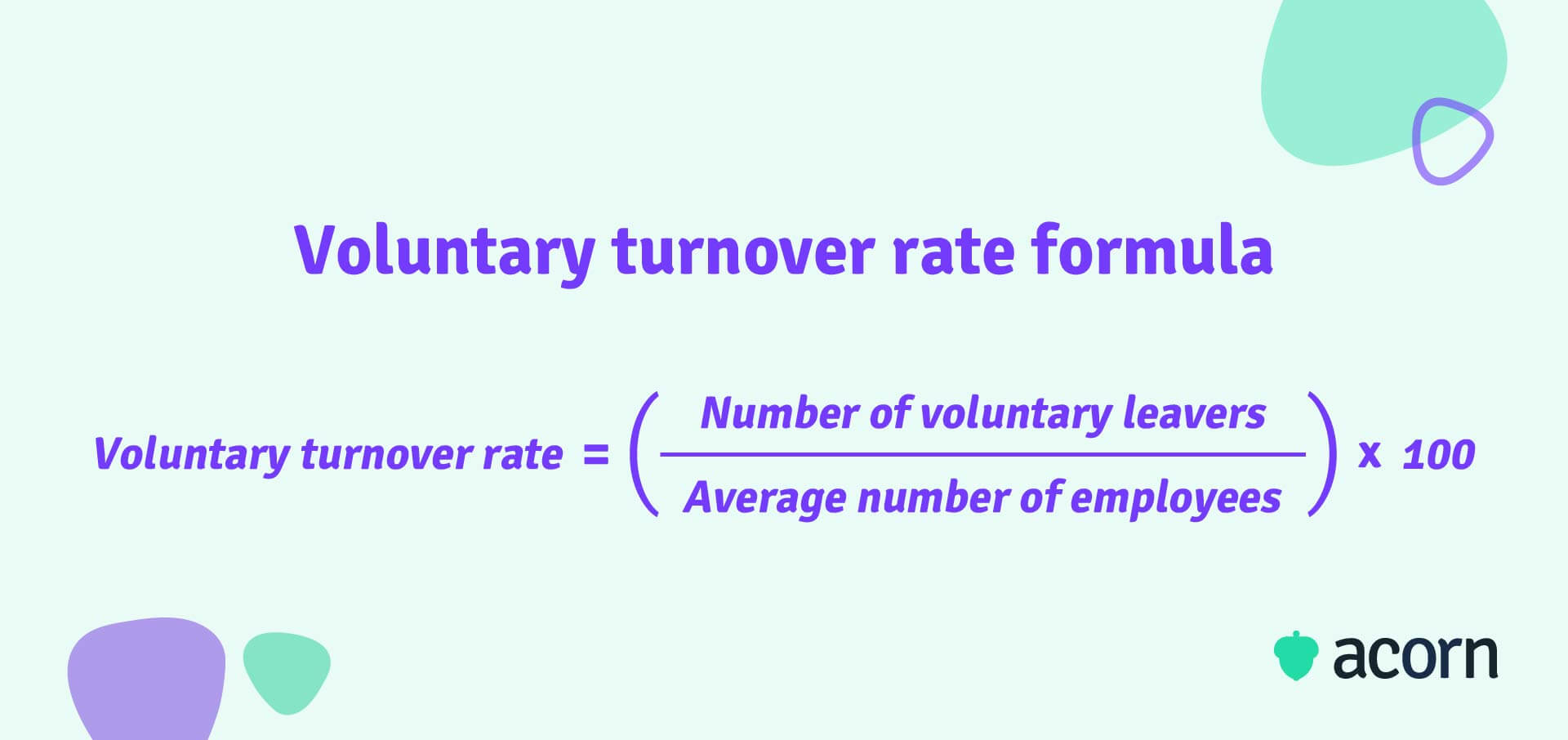
Calculating voluntary employee turnover rates can be done in four simple steps.
- Determine your period of time. This is the time frame you want to calculate employee turnover for. It could be for a year, quarter, month—any period of time you like. Ideally, you want to be able to accurately compare your employee turnover rates over time, so ensure you aren’t measuring a year here or a month there. Let’s say in this case, you want to find the annual turnover rate of a specific year.
- Identify how many employees left voluntarily during that time period. Remember, these are your voluntary leavers only. Let’s say that during this specific year, you had 30 employees leave.
- Determine the average number of employees during the specified time period. Your average number of employees in this step depends on what you’re measuring for. If you want to determine overall voluntary turnover for your business, your number will be the average number of employees across your entire business. But if you’re looking into the voluntary turnover rate of a specific department, you’ll take the average number of employees from that department. For our example, let’s say that your organisation had an average of 500 employees across the whole business for your specified year.
- Divide the number of voluntary terminations by the average number of employees over that time, then multiply the result by 100. So, for our example, you would divide your 30 leavers by your average number of employees (500), then multiply by 100 to get the voluntary turnover rate percentage.
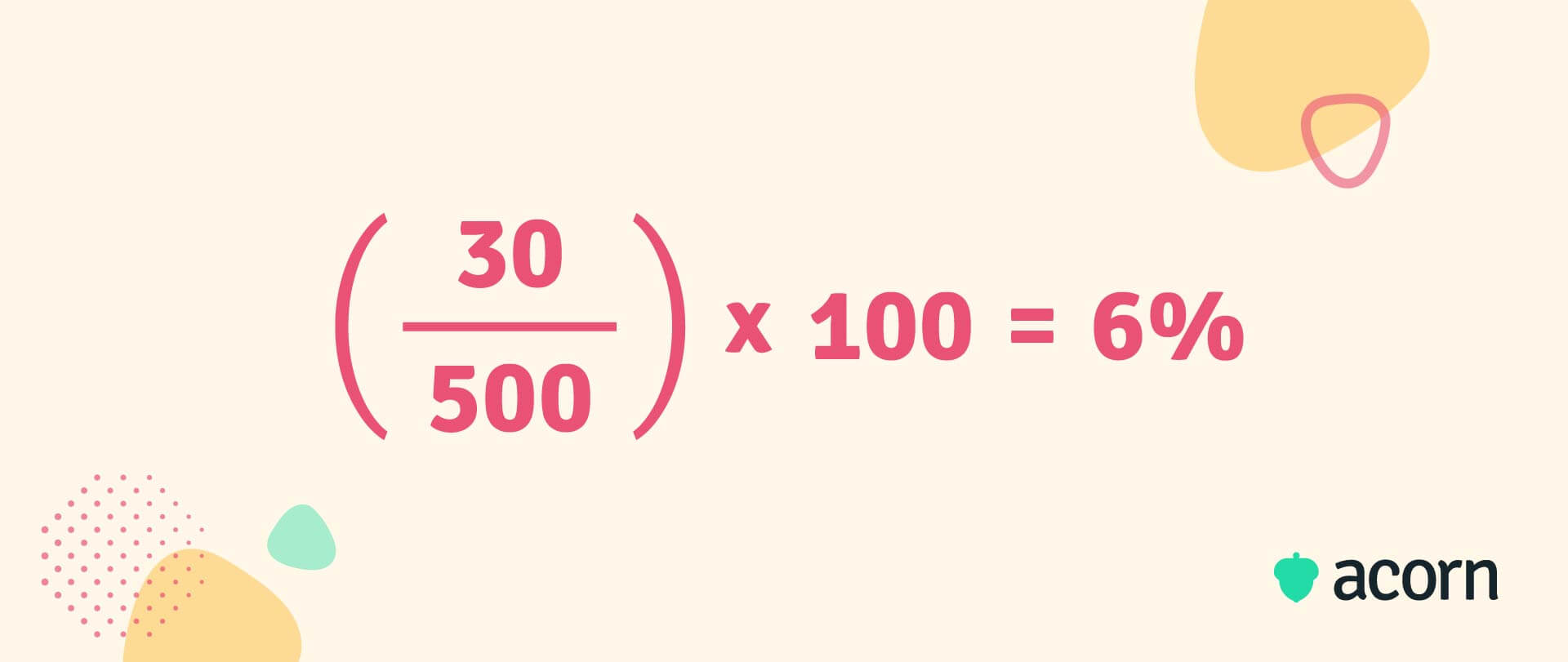
So, with all the components together, that makes your voluntary turnover rate for that year 6%.
From here, you can turn your mind to turnover analysis. This isn’t just about calculating your turnover percentage and leaving it at that. You need to use this metric alongside information gleaned from exit interviews to discover why employees left and if there’s anything you can improve within the organisation to prevent that in the future, such as if employees left for new job opportunities that offer a better work-life balance.
What happens when you don’t track voluntary turnover?
Tracking when and why employees willingly choose to leave can highlight trends or issues that calculating overall turnover might not reveal at all.
- Bad budgeting. When you don’t have the data on voluntary turnover, you don’t have an accurate understanding of the costs associated with an employee leaving. If this isn’t clear, you can’t accurately budget for the recruitment and hiring process, training or onboarding costs, leading to unexpected or additional expenses when replacing employees. This can eat into your profits and effect your bottom line.
- Reduced employee retention. Not tracking voluntary turnover and the reasons behind it leaves an organisation unaware of potential issues that are causing employees to leave. This means the contributing factors won’t be addressed, potentially driving job dissatisfaction and turnover among remaining staff. Plus, an outgoing employee takes their knowledge and capabilities with them, which can decrease productivity and morale further, particularly if they’re subject matter experts in their field.
- Difficulty identifying areas for improvement. This is the crux of what voluntary turnover shows you: Problem areas. Without tracking voluntary turnover, a business won’t know which departments, teams or managers are seeing higher rates of turnover, and therefore won’t know to investigate the driving causes. And so the problems will remain, from a loss or lag in productivity, siloed work, or unhealthy workplace cultures. It also means you aren’t going to be able to implement or measure the effectiveness of your targeted retention strategies.
- Difficulty attracting talent. If a business isn’t tracking voluntary turnover, it might not know how its turnover rates compare to industry benchmarks or competitors, meaning your organisation could be falling behind competitors without you knowing. If your turnover is unusually high in comparison to other business’s in the same industry, it might be a deterrent for potential candidates, leading to positions standing vacant for longer, loss of productivity, and talent and skill shortages.
Key takeaways
Voluntary turnover is a key HR metric for tracking the turnover and retention of your workforce. It’s a natural and healthy part of running the business, but it can reveal unhealthy underlying trends in an organisation that should be addressed. This information gives your organisation the means to be proactive about turnover and retention, improving business health and success.
Related Reads on This Topic

What is Employee Turnover and How You Can Calculate Your Employee Turnover Rate
Employee turnover is the natural cycle of vacancy and recruitment in a business. But how do you calculate it, and why should you…

What is Succession Planning and Why Is It Important for Business Strategy?
Succession planning can play a major role in ensuring productivity and workforce planning. Find out more about it and why it’s important…

Can the Internal Talent Marketplace Truly Create Workforce Agility?
The internal talent marketplace allows individuals to meet career goals and drives business strategy, but how does technology help enable it…
